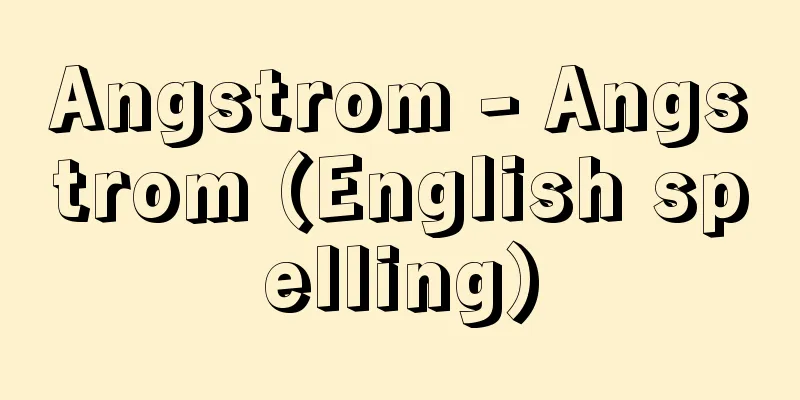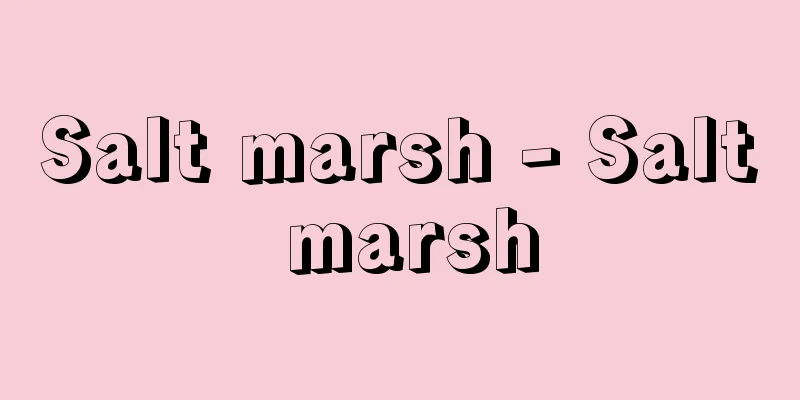Cocktail - Kakuteru (English spelling) cocktail

|
Generally, it is a kind of mixed drink that is made by mixing various alcoholic beverages, fruit juice, syrup, etc. just before drinking to create a new, distinctive aroma and flavor. However, some cocktails are also available in bottles and cans on the market. [Hara Masamichi] OriginCocktails first appeared in America between the end of the 18th century and the 19th century, and there are various theories about the origin of the name. One theory is that a Toltec nobleman in ancient Mexico created a rare concoction and presented it to the king with the help of his beautiful daughter Xochitol, and the king was so pleased that he named it Xoctl. Another theory is that it began when Anthony Peychaud, a New Orleans herbalist, created a mixed liquor similar to eggnog, which people called coctail and loved to drink. Another theory is that it comes from the word cock tail. In any case, it developed in America at the end of the 18th century and spread around the world in the 20th century. In Japan, it is said to have been served at the Rokumeikan in the early Meiji period. In the 1920s, cocktail bars opened in Tokyo. [Hara Masamichi] kindsIt is said that there are thousands of different types of cocktails, but they can be broadly divided into short drinks and long drinks. Short drinks are so-called full-fledged cocktails, including the gin-based Martini, the Gimlet, the whiskey-based Manhattan, the Old Fashioned, the brandy-based Alexander, the Sidecar, the vodka-based Screwdriver, and the rum-based Daiquiri. All of these are served in cocktail glasses, with a volume of about 60 milliliters, and are supposed to be drunk in two or three sips in a short time. Other unusual drinks include the pousse-café and the frappe. The former is made by pouring various colored ingredients such as liqueur, distilled spirits, and syrup in order of gravity so that they do not mix together, such as the pousse-café No. 1 and Angel Kiss, which were once popular and were called five-colored drinks. The latter, the frappe, is made by filling a glass with a mountain of finely crushed ice, pouring in liqueur, etc., and drinking it through a cut straw. The Benedictine frappe is a well-known example. Long drinks are made over a relatively long period of time, and in large quantities. Fizz is a drink made by adding carbonated water and ice to distilled alcohol, with the gin fizz being a famous example. Highballs are drinks made by mixing distilled alcohol with carbonated water, with whiskey being a popular choice. Sours are drinks made by adding sourness to distilled alcohol, such as whiskey sours. Coolers can be alcoholic or non-alcoholic. The former are refreshing drinks made by adding sweet and sour flavors such as lemon juice or lime juice to distilled alcohol and mixing it with ginger ale or soda, with the Boston cooler being a well-known example. Juleps are minty drinks that are drunk just before they freeze. A tumbler is filled with crushed ice, the alcohol is poured into another glass, young mint leaves and sugar are added and lightly crushed, the mint is removed, and the drink is poured into the previous tumbler and mixed with a spoon until the surface freezes. A mint sprig or leaf is always added as a garnish. Examples include the rum julep. Cobbler is a drink that is said to be good for recovering from fatigue in hot weather, and is a mixture of crushed ice, fruit syrup, and a base alcoholic beverage. Examples include claret cobbler. Daisy is a drink made by adding sweet and sour flavors such as lemon juice, lime juice, syrup, and sugar to distilled alcohol. Slings are made by adding sweet and sour flavors such as cherry brandy to distilled alcohol and diluting it with water, and examples include the Singapore sling. Another typical American drink is eggnog, a nutritious drink made from eggs, milk, and alcohol that is often consumed at Christmas and other times. Punch is made as a party drink, and claret punch is a famous example. [Hara Masamichi] How to make itEach cocktail has a set recipe, which must be followed before making it. There are two ways to mix the ingredients: using a shaker or stirring in a mixing glass. The former is used when using ingredients that are difficult to mix, such as juice, sugar, milk, and eggs. The latter is used when using ingredients that are relatively easy to mix, such as sake and sake, or sake and syrup. In either case, a set amount of sake or other ingredients must be added, followed by ice, and then quickly shaken or stirred. [Hara Masamichi] Classification by drinking methodCocktails are cold drinks, so they should be drunk before they get hot. Cocktails vary depending on the time and place you drink them. They can be classified as follows: (1) Appetizer cocktail: A light cocktail drunk to stimulate the appetite, such as a Manhattan or a Matheny. (2) Club Cocktails: Beautifully colored and nutritious cocktails served instead of hors d'oeuvres or soup, such as Clover Club and Bermuda Rose Cocktail. (3) After-dinner cocktail: A sweet cocktail to be enjoyed after a meal, such as the Alexander. (4) Supper cocktail: A dry cocktail for dinner, such as an absinthe cocktail. (5) Nightcap Cocktail: A cocktail to be enjoyed before bed. Many of these cocktails contain Cointreau, anise or egg brandy. (6) Champagne cocktail: A cocktail used at celebratory parties. [Hara Masamichi] Raw materialsCocktails are made by deciding on a base (base liquor) and then adding flavor, aroma, and color. Lemon, orange, lime, grapefruit, olive, cherry, etc. are used as fruit (juice). In addition, various syrups are used for sweetness, bitters (bitter liquor) and various spices are used to tighten the flavor, and various sodas are used for long drinks. Milk, cream, eggs, and sugar are used as secondary ingredients, and mineral water and ice are essential. Distilled liquor such as gin, whiskey, brandy, vodka, rum, and shochu are mainly used as bases, but there are also cocktails based on liqueurs such as absinthe, anisette, apricot brandy, and curacao, as well as vermouth, champagne, wine, and sake. [Hara Masamichi] EquipmentThe tools used for cocktails include shakers and mixing glasses for mixing, bar spoons for stirring, strainers for pouring into the mixing glass to separate the ice from the cocktail, jiggers (measuring cups) for measuring the amount of alcohol, squeezers for making juice, ice picks for breaking ice, ice baskets for holding ice, bitters bottles for holding bitters, etc. The glasses used to serve cocktails include cocktail glasses for short drinks, medium-sized tumblers for long drinks such as highballs and fizzes, and sour glasses and punch glasses for sours and punches, respectively. [Hara Masamichi] "New Cocktail Encyclopedia" edited by Kimura Yoshio (1989, Hikari no Kuni) "NBA Official Cocktail Book" edited by the Japan Bartenders Association (1994, Shibata Shoten) [Supplementary Material] |(1) Martini (dry) (2) Gimlet (3) Manhattan (4) Sidecar (5) Alexander (6) Daiquiri ©Shogakukan "> Main types of cocktails (short drinks… (1) Gin Fizz (2) Whiskey Sour (3) Singapore Sling (4) Peppermint Frappe (5) Mai Tai (6) Salty Dog ©Shogakukan "> Main types of cocktails (long drinks… (1) Shaker (2) Jigger (3) Mixing glass (4) Strainer (5) Squeezer (6) Ice basket (7) Ice tongs (8) Screw opener (9) Sizzler (10) Ice pick (11) Paring knife (12) Bar spoon (13) Muddler (14) Duster ©Shogakukan "> Cocktail Equipment Source: Shogakukan Encyclopedia Nipponica About Encyclopedia Nipponica Information | Legend |
|
一般には飲用の直前に種々の酒類、果汁、シロップなどを混ぜて、特徴ある新しい香りと味をつくりだして飲む、一種の混成飲料のことである。ただし、一部にはカクテルの瓶詰、缶詰も市販されている。 [原 昌道] 由来カクテルは18世紀末から19世紀にかけて、アメリカで始まったもので、カクテルの名の由来についてはいろいろな説がある。古代メキシコのトルテカ人の一貴族が珍しい調合酒をつくって、美しい娘のコキトルXochitolの手で国王に献上したところ、王は非常に喜んでこの酒をコクトルXoctlと命名したという説、またアメリカ、ニュー・オーリンズの薬酒商、アントニー・ペイショーが調合した卵酒のような混成酒を人々がコクテエーといって愛飲したのが始まりという説、またcock tail(おんどりの尾)に由来する説もある。いずれにせよ18世紀の末にアメリカで発達し、20世紀になって世界に普及した。日本では明治初期に鹿鳴館(ろくめいかん)で供されたという。1920年代には東京にカクテルバーが開かれた。 [原 昌道] 種類カクテルの種類は数千種あるといわれるが、大きく分けて、ショートドリンクスとロングドリンクスに分かれる。 ショートドリンクスはいわゆる本格カクテルであり、そのなかには、ジンをベースにしたマテニー(マティーニ)、ギムレット、ウイスキーをベースにしたマンハッタン、オールドファッション、ブランデーをベースにしたアレキサンダー、サイドカー、ウォツカをベースにしたスクリュードライバー、ラムをベースにしたダイキリなどがある。これらはいずれもカクテルグラスを用い、量は60ミリリットル程度で、二口(くち)か三口で短時間に飲み干すのが正しいとされている。そのほか変わったものとしてプースカフェとフラッペがある。前者は、リキュールや蒸留酒、シロップなどいろいろな色彩のものを、比重の重いものから順に混ざらないようについだもので、かつて五色酒といわれて流行したプースカフェナンバーワンやエンゼルキッスなどがある。後者のフラッペは、細かく砕いた氷をグラスに山盛りに詰め、リキュールなどを注ぎ、カットストローで飲む。ベネディクティンフラッペなどが知られている。 ロングドリンクスは比較的時間をかけて飲むもので、量も多くつくられる。フィズ(泡)は蒸留酒に炭酸水と氷を加えた飲み物で、ジンフィズが有名。ハイボールは蒸留酒を炭酸水で割った飲み物をいい、ウイスキーを用いたものがよく飲まれる。サワーは蒸留酒などに酸味を加えた飲み物で、ウイスキーサワーなどがある。クーラーは酒精含有と無酒精のものがあり、前者は蒸留酒にレモンジュース、ライムジュースなどの甘酸味を加え、ジンジャーエール、ソーダなどで割った清涼感のある飲み物で、ボストンクーラーなどが知られている。ジュレップは凍る寸前に飲むミントの香りをもった飲み物で、タンブラーに砕氷を詰め、別のグラスに酒をつぎ、ミントの若葉と砂糖を加えて軽くつぶし、ミントを除いてから前のタンブラーについで、表面が氷結するまでスプーンで混ぜる。かならずミントの小枝または葉を飾りにつける。ラムジュレップなどがある。コブラーは暑いときの疲労回復によいとされる飲み物で、砕いた氷とフルーツシロップとベースとなる酒の混合酒である。クラレットコブラーなどがある。デージー(ヒナギク)は蒸留酒にレモンジュース、ライムジュース、シロップ、砂糖などの甘酸味を加えた飲み物である。スリングは蒸留酒にチェリーブランデーなどの甘酸味をつけ、水で割ったもので、シンガポールスリングなどがある。そのほかアメリカの代表的な飲み物にエッグノッグがある。これは卵と牛乳と酒からなる滋養に富んだもので、クリスマスなどによく飲まれる。パンチはパーティー用飲み物としてつくられ、クラレットパンチなどが有名である。 [原 昌道] 作り方各カクテルにはそれぞれ処方が決められており、それに従ってつくる。材料を混ぜ合わせる方法には、シェーカーを使う方法とミキシンググラスで混ぜる方法(ステア)がある。前者はジュース、砂糖、ミルク、卵など混ざりにくい材料を使う場合に用いる。後者は酒と酒、酒とシロップなど比較的混ざりやすいものを使うときに用いる。いずれも決まった分量の酒などを入れ、その後氷を加え、手早くシェークするか、ステアすることが必要である。 [原 昌道] 飲み方による分類カクテルは冷たい飲み物であるから、温まらないうちに飲み干す。なおカクテルは飲む時と場所によって種類が異なる。それを分類すると次のようになる。 (1)アペタイザーカクテル 食欲増進の意味で飲まれる軽いカクテル。マンハッタン、マテニーなど。 (2)クラブカクテル オードブルやスープのかわりに供され、色が美しく滋養に富んだカクテル。クローバークラブ、バーミューダローズカクテルなど。 (3)アフターディナーカクテル 食後のカクテルで甘味の強いもの。アレキサンダーなど。 (4)サパーカクテル 晩餐(ばんさん)用の辛口カクテル。アブサンカクテルなど。 (5)ナイトキャップカクテル 就寝前のカクテル。コアントロー、アニスやエッグブランデーを用いたカクテルが多い。 (6)シャンパンカクテル 祝宴に用いられるカクテル。 [原 昌道] 原料カクテルの製法は、ベース(基酒)を決め、これに味や香り、色を添えていく。果実(果汁)としてはレモン、オレンジ、ライム、グレープフルーツ、オリーブ、チェリーなどが使われる。そのほか、甘味用に各種シロップ、味を引き締めるためにビターズ(苦味酒)や各種香辛料、ロングドリンクスでは各種ソーダ類が使われる。また副材料としてミルク、クリーム、卵、砂糖が用いられ、ミネラルウォーターと氷は必需品である。ベースとしてはジン、ウイスキー、ブランデー、ウォツカ、ラム、焼酎(しょうちゅう)などの蒸留酒がおもに使われるが、アブサン、アニゼット、アプリコットブランデー、キュラソーなどのリキュールをベースにしたり、ベルモット、シャンパン、ワイン、清酒をベースにしたカクテルもある。 [原 昌道] 器具カクテルに使う用具としては、混合用のシェーカーやミキシンググラス、かき混ぜるバースプーン、ミキシンググラスにかけて氷とカクテルを分けるのに使うストレーナー、酒の量を測るジガー(メジャーカップ)、ジュースをつくるスクイザー、氷割り用のアイスピック、氷を入れるアイスバスケット、ビターズを入れるビターズボトルなどがある。カクテルを入れるグラスは、ショートドリンクスのカクテル用にはカクテルグラスが、またハイボールやフィズなどのロングドリンクスには中形タンブラーが、サワーやパンチにはそれぞれサワーグラス、パンチグラスが使われる。 [原 昌道] 『木村与三男編著『新カクテール全書』(1989・ひかりのくに)』▽『日本バーテンダー協会編著『NBAオフィシャル・カクテルブック』(1994・柴田書店)』 [補完資料] |(1)マテニー(マティーニ)〈ドライ〉 (2)ギムレット (3)マンハッタン (4)サイドカー (5)アレキサンダー (6)ダイキリ©Shogakukan"> カクテルのおもな種類(ショートドリンク… (1)ジンフィズ (2)ウイスキーサワー (3)シンガポールスリング (4)ペパーミントフラッペ (5)マイタイ (6)ソルティドッグ©Shogakukan"> カクテルのおもな種類(ロングドリンクス… (1)シェーカー (2)ジガー (3)ミキシンググラス (4)ストレーナー (5)スクイーザー (6)アイスバスケット (7)アイストング (8)スクリューオープナー (9)シズラー (10)アイスピック (11)ペティナイフ (12)バースプーン (13)マドラー (14)ダスター©Shogakukan"> カクテル用具 出典 小学館 日本大百科全書(ニッポニカ)日本大百科全書(ニッポニカ)について 情報 | 凡例 |
Recommend
Jean I Androuet du Cerceau
...His eldest son, Baptiste Androuet du Cerceau (...
Transformation diagram - Hensozu
Henso means a concrete form, and can also be calle...
Kanton
According to a 1990 survey, the proportion of Swi...
Plug - Plug (English spelling)
A wiring device used for plugging in electrical c...
Marie-Jean-Antoine Nicolas de Caritat, Marquis de Condorcet
French mathematician, philosopher, and politician...
Dictatorial (English spelling)
The highest magistrate in ancient Rome in times of...
Oga Decken - Oga Decken
...The main industry is agriculture, mainly field...
marmem effect (English spelling)
…This is the shape memory effect. Since this is a...
Electronic scale (electronic balance) - Denshibakari (English spelling) electronic scale
A general term for scales that incorporate electro...
Onbashira pulling rope
…There are many examples of using strings in conn...
Sanbu Kyūkōshin (English: Three Parts and Nine Symptoms of Diagnosis)
A method of diagnosing illnesses used in China. Th...
Kiyoshi Hiraizumi
A historian who made a great contribution to the ...
Niccolò Piccinni (Piccini)
1728‐1800 Italian opera buffa composer. After work...
Anrakuji Temple (Fukuoka) - Anrakuji
…However, because these Kyushu Tandai were all fo...
Building Standards Act
This law aims to protect the lives, health, and p...









